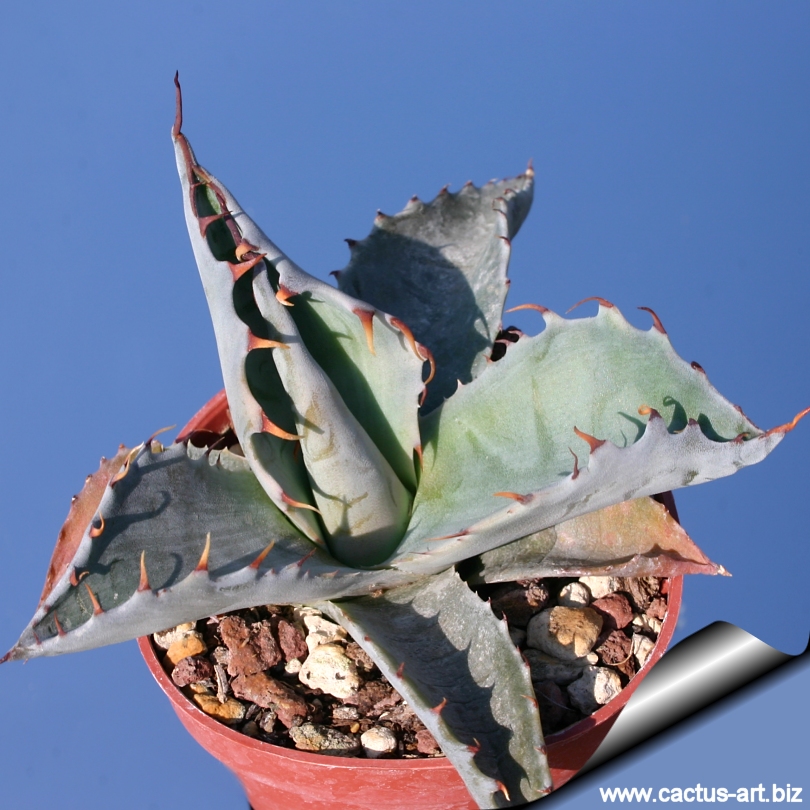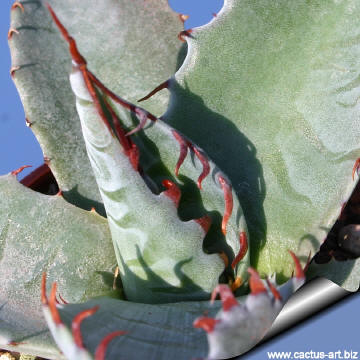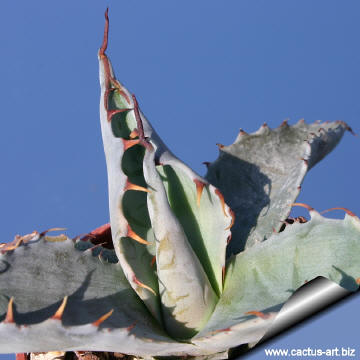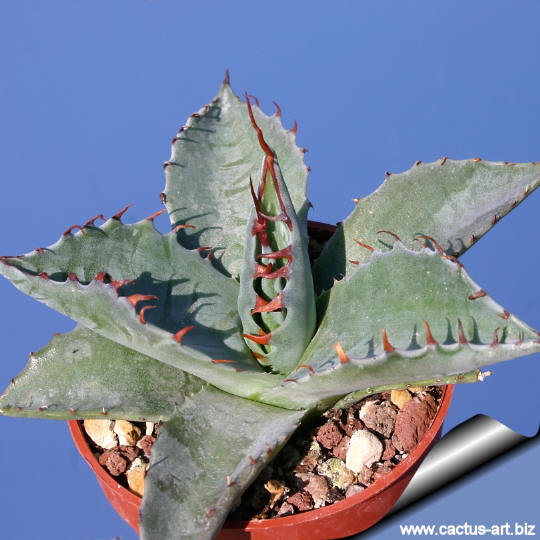|
|
|

Agave parrasana (A juvenile specimen)
What a beauty of a miniature Agave! It is among the most
ornamental species, vying with
A. victoria-reginae in the exquisite regularity of its form.
The young plants are quite different
from the adults, but are however very lovely too.
|
|
Description: A. parrasana is a
compact, chunky, small sized agave related and similar to Agave
parryi. It has very short broad leaves that form into a tight,
symmetrical, spherical rosette, shaped like a 'globe artichoke' 40-60 cm
tall, 30-50(-90) cm in diameter. It produces few or no offsets but can
form small mounds in the pot or landscape.
Leaves: 40-60 per rosette, waxy grey or blue-grey and closely
overlapping. They are short, stout and broad, obovate, nearly round,
measuring 20-30(-40) cm long and nearly 10-20 cm wide. Plane to concave
above. They are edged with decorative but variable greenish-brown,
straight to curved teeth. The teeth are largest near the leaf tip,
getting smaller towards the base. the leaves end in a sharp thin red
spine 2-2,5(-4) cm long and decurrent. The leaves are held tightly,
almost like a bud, giving the plant a very distinctive form. Colour and
tooth form are indeed quite variable.
Flowers: In bud, the flowers are flushed with red or purple and
open yellow, they appear on a 3- 4(-6) m tall ellipsoid panicle with
12-15 branches. The flowers are enclosed into large, reddish to purplish
bracts that subtend the clusters of flowers.
Blooming season: Early summer (June-July). Remember that the
plant will flower once, then it dies.
|
 |
 |
|
Advertising
|
|
|
|
|
|
|
Family: Agavaceae
Scientific Name: Agave
parassana Berger
In: Notizbl. Königl. Bot. Gart.
Berlin 4: 250, 1906
Origin: Endemic to a very
small area in south-eastern Coahuila (Mexico)
Habitat: Mountainous
areas 1350-2400 m in elevation. Grows on grassy slopes, in chaparral
shrub and pine-oak forests on limestone.
Synonyms:
- Agave wislizeni ssp. Parrasana
(A. Berger) Gentry 1975
(Incorrect name, Art. 11.4)
|
|
|
|

Cultivation: A.
parrasana
is a stunning specimen
plant for containers or a well drained spot in the garden noted as rare
in cultivation. It tend to be
slow grower, taking several years to achieve a mature size,
but worth the effort. Grow them
in porous soil with adequate drainage. They
should be grown only in full sun.
The leaves will keep their blue-gray
color and the plants will stay more compact. Water thoroughly when soil
is dry to the touch. In winter watering this
plant can be done once every 1-2 months, there is no need to mist the
leaves. It is a cold hardy
species, tolerating temperatures down to at least 9° C
particularly when dry but it is best to avoid
severe
freezing temperatures. Heat and
drought tolerance: Excellent.
Propagation:
Relatively easy to propagate by seeds or by
suckers (if available) Remove the basal suckers in spring or
summer and let the cuttings dry for a few days before inserting in
compost.. only problem is the
logistics of getting to the suckers - very sharp spines and suckers
usually right up against, or underneath the mother plant.
Uses: Agave parrasana make great
potted plants as well as excellent landscape plants.
They are wonderful when used for accent or simply to
provide some all year round foliage colour and often used in a pot as a
patio plant, they make an eye-catching statement and along with other
evergreen plants in pots, can be moved around to change the scenery or
position to give more shelter.

 |
|